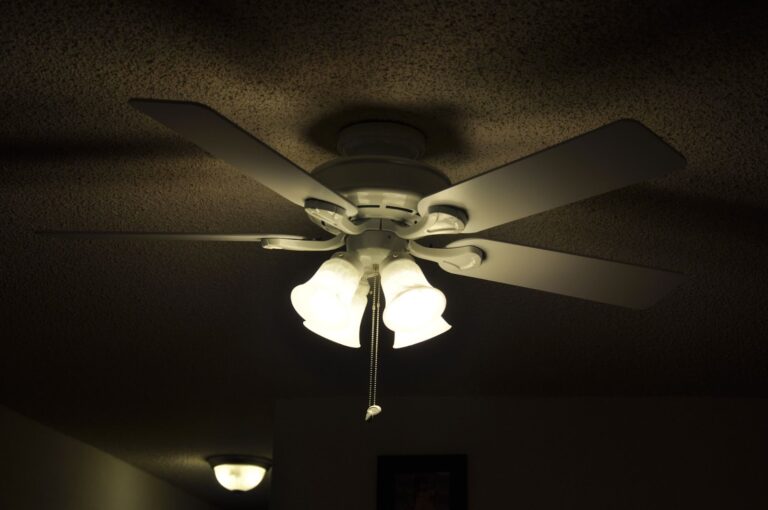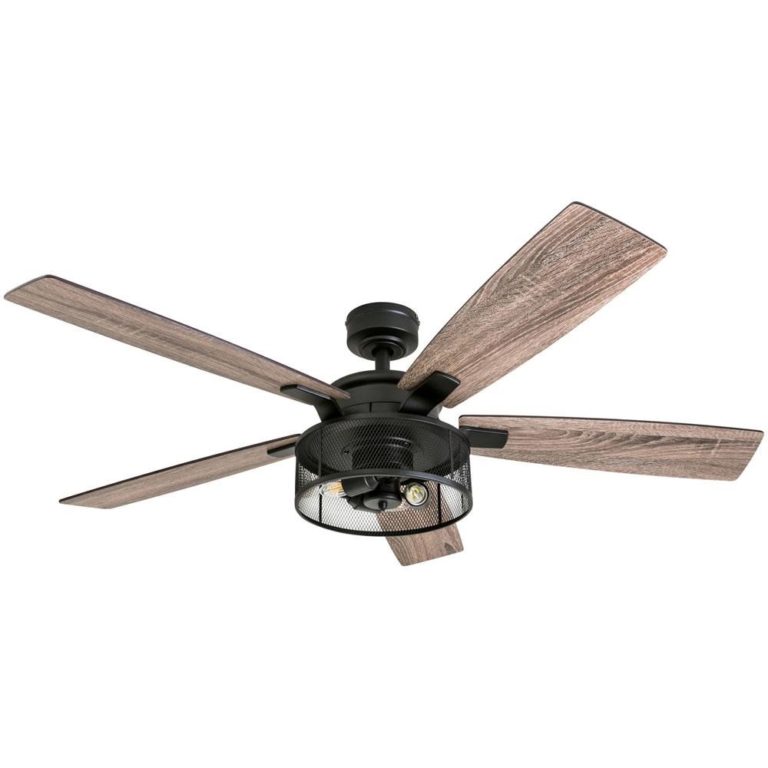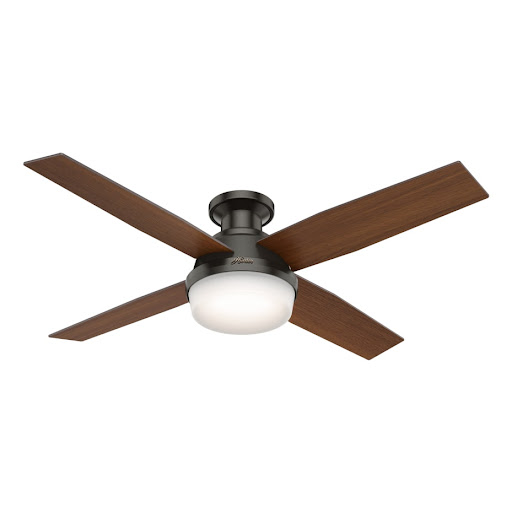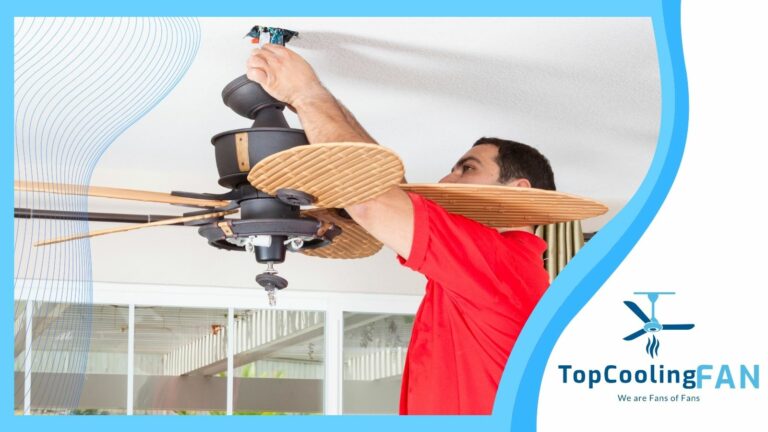Ceiling Fan vs. AC: Which is the Better Cooling Option?
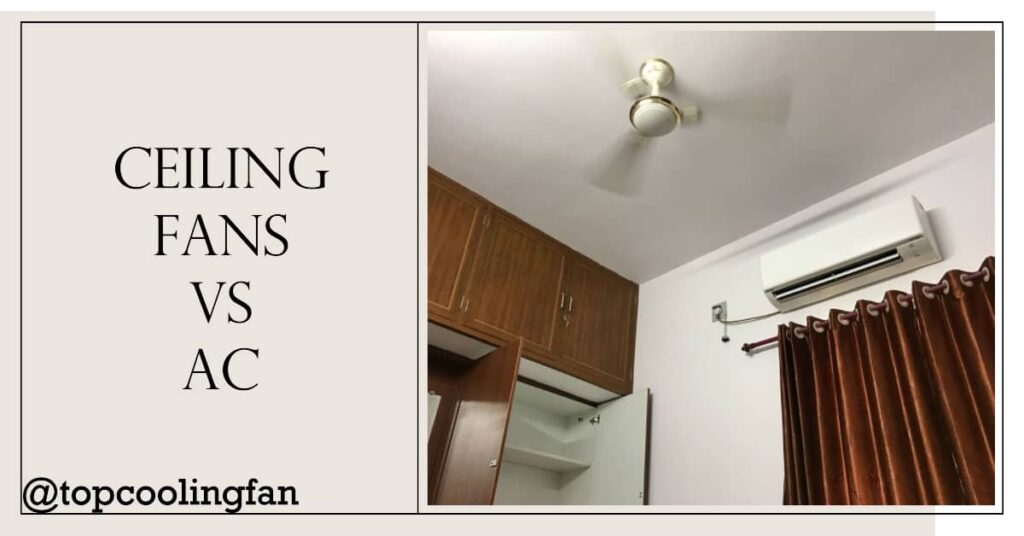
When it comes to keeping our homes cool during the hot summer months, there are two main options that come to mind: ceiling fans and air conditioning units. While both are effective at lowering the temperature in a room, they have their own unique advantages and disadvantages.
In this article, we will be exploring the differences between ceiling fans and AC units, and which one may be the better choice for your home.
First and foremost, it’s important to consider the cost difference between the two options. While ceiling fans are generally much cheaper to install and operate than AC units, they may not provide the same level of cooling power.
According to ceilingfanpro.com, a ceiling fan is only pennies per day to operate, while an AC unit can significantly increase your electricity bill. However, if you live in an extremely hot and humid climate, a ceiling fan may not be enough to keep you comfortable.
Another factor to consider is the environmental impact of your cooling choices. While both ceiling fans and AC units consume electricity, AC units tend to use significantly more energy.
According to Cielo Breez, “air conditioners give much greater cooling power but at a disproportionately higher cost.” If you’re looking to reduce your carbon footprint and save on energy costs, a ceiling fan may be the more sustainable choice.
Ceiling Fan vs. AC: Understanding the Basics
Ceiling fans and air conditioners are two of the most common ways to cool down a room. While both appliances serve the same purpose, they have different designs and operate differently. In this section, we will explore the basics of ceiling fans and air conditioners, including how they work and their benefits.
How Ceiling Fans Work
Ceiling fans work by circulating air in a room, creating a wind-chill effect that makes the room feel cooler. The blades of the fan rotate in a circular motion, pushing air downwards and creating a breeze. When the breeze hits your skin, it evaporates sweat and cools you down.
Ceiling fans do not actually lower the temperature in the room, but they make you feel cooler by creating a wind-chill effect. This means that if you leave a ceiling fan on in an empty room, it will not actually cool the room down. However, if you are in the room and feeling hot, a ceiling fan can make you feel more comfortable.
How Air Conditioners Work
Air conditioners work by removing heat and moisture from the air in a room, then blowing cool air back into the room. The process starts with the refrigerant, which absorbs heat from the air and turns into a gas. The gas is then compressed, which raises its temperature even further.
Next, the gas is sent through a series of coils, where it releases heat and turns back into a liquid. Finally, the liquid refrigerant is sent back through an expansion valve, where it evaporates and absorbs heat again, starting the cycle all over. Air conditioners can cool down a room quickly and effectively, and they can lower the temperature in a room to a desired level.
However, they also use a lot of energy and can be expensive to run. In summary, ceiling fans and air conditioners work differently, but they both have their benefits. Ceiling fans create a wind-chill effect that makes you feel cooler, while air conditioners actually lower the temperature in a room.
Both appliances have their place in cooling down a room, and the choice between the two depends on personal preference and the specific needs of the situation.
Pros and Cons of Ceiling Fans
Ceiling fans are a popular choice for homeowners looking to cool their homes without breaking the bank. While they have many advantages, there are also some downsides to using ceiling fans as opposed to air conditioning. In this section, we will explore the advantages and disadvantages of ceiling fans in more detail.
Advantages of Ceiling Fans
There are several advantages to using ceiling fans in your home:
- Ceiling fans are much more energy-efficient than air conditioning units. According to the U.S. Department of Energy, ceiling fans can save you up to 40% on your cooling costs during the summer.
- They are relatively inexpensive to purchase and install. While air conditioning units can cost thousands of dollars, a good quality ceiling fan can be purchased for a few hundred dollars or less.
- Ceiling fans are versatile and can be used in a variety of rooms, including bedrooms, living rooms, and outdoor spaces.
- They come in a wide variety of styles and designs, so you can easily find one that fits your home’s decor.
- Ceiling fans can be used in conjunction with air conditioning units to help circulate cool air throughout your home more efficiently.
Disadvantages of Ceiling Fans
While there are many advantages to using ceiling fans, there are also some downsides to consider:
- Ceiling fans only circulate air, they do not cool it. This means that they are not as effective as air conditioning units in extremely hot weather.
- Ceiling fans can be noisy, especially if they are not installed properly or if they are old and worn out.
- They can be difficult to clean and maintain, especially if they are located in hard-to-reach areas.
- Ceiling fans can be dangerous if they are not installed properly or if they are not used correctly. For example, if the blades are too close to the ceiling or if they are not balanced correctly, they can wobble or even fall off.
Pros and Cons of AC
Advantages of AC
AC units are known for their ability to cool a room quickly and effectively. They can lower the temperature of a room by several degrees in a short amount of time, making them ideal for hot summer days. AC units are also able to maintain a constant temperature, which is great for those who prefer a consistent climate.
Another advantage of AC units is that they can filter the air in a room, removing pollutants such as dust, pollen, and pet dander. This is especially beneficial for those who suffer from allergies or respiratory issues.
AC units can also be used to dehumidify a room, which can be helpful in humid climates. By removing excess moisture from the air, AC units can prevent the growth of mold and mildew.
Disadvantages of AC
One of the main disadvantages of AC units is their cost. They can be expensive to purchase and install, and they also require regular maintenance to ensure they continue to function properly.
AC units also consume a lot of energy, which can lead to high electricity bills. They are not as energy-efficient as other cooling options, such as ceiling fans, which can be a more cost-effective option in the long run.
Another disadvantage of AC units is that they can dry out the air in a room, which can be uncomfortable for some people. This can be mitigated by using a humidifier in conjunction with the AC unit.
Finally, AC units can be noisy, which can be a problem for light sleepers or those who prefer a quiet environment. Some units are quieter than others, so it’s important to do research and read reviews before purchasing an AC unit.
Energy Efficiency
When it comes to cooling your home, energy efficiency is an important factor to consider. Choosing between a ceiling fan and an air conditioning unit can have a significant impact on your energy consumption and costs.
In this section, we will explore the energy efficiency of ceiling fans and air conditioning units, including a comparison of energy costs and environmental impacts.
Energy Cost Comparison
One of the most significant differences between ceiling fans and air conditioning units is their energy consumption and cost. According to the U.S. Department of Energy, running a ceiling fan costs approximately one cent per hour, while running a central air conditioning unit can cost up to 70 cents per hour.
While the initial cost of an air conditioning unit may be higher than that of a ceiling fan, the ongoing energy costs can quickly add up. In fact, Consumer Reports estimates that running a ceiling fan for eight hours a day over the course of a summer can cost as little as $1, while running a central air conditioning unit for the same amount of time can cost up to $350.
It’s important to note that the energy cost of an air conditioning unit can vary depending on factors such as the size of your home, the efficiency of the unit, and the climate in your area. However, in most cases, a ceiling fan will be a more energy-efficient and cost-effective option for cooling your home.
Environmental Impact
In addition to energy costs, it’s important to consider the environmental impact of your cooling system. Air conditioning units use refrigerants that can contribute to ozone depletion and climate change. In fact, according to the U.S. Environmental Protection Agency, the refrigerants used in air conditioning units are some of the most potent greenhouse gases in existence.
On the other hand, ceiling fans do not use refrigerants and do not contribute to ozone depletion or climate change. In fact, using a ceiling fan can actually help reduce your carbon footprint by allowing you to use your air conditioning unit less frequently.
It’s worth noting that some air conditioning units are designed to be more environmentally friendly than others. For example, Energy Star certified air conditioning units meet strict energy efficiency guidelines and use refrigerants that are less harmful to the environment. However, even the most efficient air conditioning unit will still have a greater environmental impact than a ceiling fan.
Overall, when it comes to energy efficiency and environmental impact, ceiling fans are the clear winner. While air conditioning units may be necessary in some situations, using a ceiling fan as much as possible can help reduce your energy costs and environmental footprint.
Performance Comparison
Temperature Control
When it comes to temperature control, air conditioners have an edge over ceiling fans. ACs are designed to cool the air and lower the temperature of a room. They can quickly bring down the temperature to a comfortable level, even in hot and humid weather.
On the other hand, ceiling fans do not lower the temperature of a room. They simply circulate the air to create a cooling effect on your skin. However, air conditioners consume a lot more energy than ceiling fans.
According to Consumer Reports, “central air conditioning systems use about 3,500 watts of power, while a ceiling fan will use only 60 watts on high speed.” This means that running an AC for an extended period can significantly increase your energy bills.
Air Circulation
Ceiling fans excel at air circulation. They can create a breeze that circulates the air in a room, making it feel cooler and more comfortable. This is especially useful in rooms with poor ventilation or during the summer months when the air is stagnant.
Air conditioners can also circulate air, but they do so differently. They draw in warm air from a room, cool it down, and then release it back into the room. This process can create a draft, but it doesn’t necessarily circulate the air as effectively as a ceiling fan.
Humidity Control
Air conditioners are great at reducing humidity levels in a room. When they cool down the air, they also remove moisture from it. This is why air conditioners are often used in humid climates to reduce the stickiness and discomfort caused by high humidity.
Ceiling fans, on the other hand, do not directly control humidity levels. However, they can indirectly reduce humidity levels by creating air movement that helps to evaporate sweat and moisture from your skin. This can make a room feel less humid and more comfortable.
In summary, both ceiling fans and air conditioners have their strengths and weaknesses when it comes to temperature control, air circulation, and humidity control. Depending on your needs and preferences, one may be more suitable than the other.
Installation and Maintenance
Ceiling Fan Installation and Maintenance
When it comes to installing a ceiling fan, it is important to follow the manufacturer’s instructions carefully. Most ceiling fans come with a mounting bracket, which should be attached securely to the ceiling joist. It is important to ensure that the bracket is level and that the screws are tightened securely.
Once the bracket is in place, the fan can be attached to the bracket using the provided screws. When it comes to maintenance, it is important to keep the fan clean to ensure that it operates efficiently.
This can be done by wiping down the blades with a damp cloth and using a soft brush to remove any dust or debris that may have accumulated on the motor housing.
AC Installation and Maintenance
Installing an air conditioning unit can be a complex process and it is often best left to professionals. The installation process will vary depending on the type of unit being installed, but generally involves connecting the unit to the electrical system and ductwork.
When it comes to maintenance, it is important to change the air filter regularly to ensure that the unit operates efficiently. This can be done by removing the filter from the unit and replacing it with a new one. It is also important to keep the unit clean by wiping down the exterior with a damp cloth and removing any debris that may have accumulated on the condenser coils.
Overall, both ceiling fans and air conditioning units require some level of installation and maintenance. It is important to follow the manufacturer’s instructions carefully and to keep the units clean to ensure that they operate efficiently.
Conclusion
After exploring the differences between ceiling fans and air conditioners, we can conclude that both have their advantages and disadvantages. Ceiling fans are more energy-efficient and cost-effective, making them a great option for those looking to save money on their electricity bills.
They are also environmentally friendly and have a longer lifespan compared to air conditioners. On the other hand, air conditioners provide faster and more effective cooling, making them ideal for hot and humid climates.
When it comes to choosing between a ceiling fan and an air conditioner, it ultimately depends on your personal preferences and needs. If you live in a relatively mild climate and want to save money on your energy bills, a ceiling fan may be the better option. However, if you live in a hot and humid climate and need fast and effective cooling, an air conditioner may be the way to go.
It’s also worth considering a combination of both options. Using a ceiling fan in conjunction with an air conditioner can help reduce energy costs while still providing effective cooling. Additionally, using a programmable thermostat can help regulate the temperature and save energy.
Overall, the decision between a ceiling fan and an air conditioner depends on various factors, including climate, budget, and personal preferences. We encourage you to weigh the pros and cons of each option and make an informed decision based on your individual needs.

